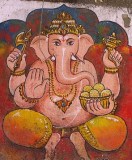So here we are in the dog days of summer. As the heat and humidity reach their pinnacle in the world around us, so does Pitta within us. Have you felt any of the following signs of high Pitta recently?
- Rashes or redness in the skin
- Hot flashes
- Impatience
- Acid reflux or heartburn
- Irritability over little things
- Road rage
- Inflammation
Pitta is easily elevated in anyone this time of year in the Northern Hemisphere, but even more so for those who have a significant proportion of Pitta in their baseline constitution, or prakriti.
Here are some quick solutions to bring that inner fire down fast:
- Spritz pure rose water over your face and eyes for an instant cool-down
- Drink coconut water or cucumber water (soak a few organic cucumber slices in a cup of water overnight) – both help cool you from the inside out
- Avoid spicy salsas and chili peppers, as well as acidic foods like tomato sauce, kombucha and grapefruit
- Schedule regular “computer screen vacations” throughout your work day, and then soothe your eyes (an organ with high concentrations of pitta) by gazing at an image of nature, especially bodies of water, or simply “palming” the eyes to let them rest in darkness
- Instead of lemonade, which is heating due to the sour taste, drink limeade (it is lime’s prabhav or mysterious effect that it is cooling despite being sour)
- Practice sheetali pranayama: roll your tongue like a straw (or press the tip of your tongue against the back of your top teeth) and breathe in through the mouth so air rushes over the tongue, then breathe out through the nose. Wait for the next inhale to arise naturally so you don’t hyperventilate. Do 12 slow rounds, then sit quietly. (This is a great antidote when someone cuts you off in traffic!)
- Create a little space in your schedule – give yourself extra time to get to an appointment, or block off a half hour at the end of your work day to close up loose ends before starting your commute
- Wear cooling colors like green and blue
- Sit for five minutes of stillness in the morning simply observing the breath, bringing the mind back to the breath each time it wanders
- When the critical or judgmental mind starts talking in your head, say to yourself, “Ah, my Pitta must be high!” and wait for a cooler moment before sharing your thoughts.
With a little forethought, we can anticipate high Pitta and take steps in advance to pacify it. Most importantly, be gentle with yourself. Stop working so hard (in all arenas) and remember that summer CAN be an invitation to adventure and fun. Put your feet up and kick back, even for five minutes – your Pitta will thank you.
* * * * *
Join me for a free webinar “Deepen Your Yoga with Ayurveda” on Tuesday, Aug. 21, at 7pm CDT (8pm EDT, 5pm PDT). Register and get more information here: http://ivyingram.com/free-webinars/



